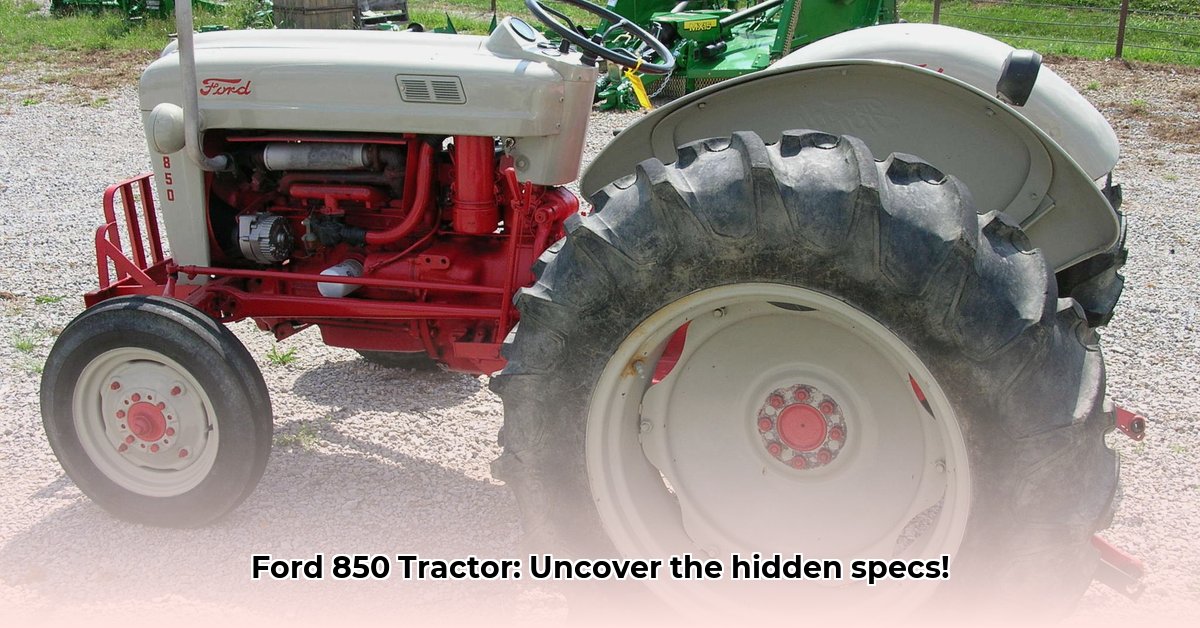
850 Ford Tractor: A Detailed Look Back at an Agricultural Icon (1954-1957)
The Ford 850 tractor, produced from 1954 to 1957 at the Highland Park, Michigan plant, holds a significant place in agricultural history. This robust machine provided farmers with a reliable blend of power and maneuverability, making it a popular choice for a variety of tasks. Its enduring legacy stems from its dependable performance and significant contribution to the mechanization of farming during the mid-20th century. But what specifically made the Ford 850 such a success? Let's delve into the details. For more on early Ford tractors, check out this resource on the 9N.
Powertrain and Performance: Under the Hood of the Ford 850
This workhorse featured a 2.8-liter engine, offering a choice between gasoline and liquid propane (LP) gas. While precise horsepower figures vary slightly depending on the testing methodology employed (a common issue with older equipment), it generally delivered approximately 40 belt horsepower, sufficient for most farming operations of the era. It readily tackled tasks such as plowing, planting, and hauling, solidifying its reputation for reliability. Did you know that fuel efficiency was a key consideration for farmers then, making engine choices crucial?
Operational Characteristics: Driving and Handling the 850
The Ford 850 boasted a 5-speed, unsynchronized transmission. This means that shifting gears required more skill and precision than modern, synchronized transmissions. While this might seem challenging, it was typical of tractors from its era. The open-air operator station offered exceptional visibility, a significant advantage for farm work. However, it also meant exposure to the elements, a trade-off many farmers were willing to accept. An optional power steering system enhanced maneuverability, reducing operator fatigue, particularly during long hours in the field. How did this feature change farming practices in its time?
Specifications and Comparative Analysis: Key Data Points
Precise specifications for the Ford 850 can be challenging to pinpoint due to variations in historical records and reporting methods. While the production years (1954-1957), engine size (2.8 liters), and fuel options (gasoline and LP gas) remain consistent across sources, variations exist in horsepower and fuel tank capacity. The table below highlights these discrepancies:
| Feature | Source A | Source B | Notes |
|---|---|---|---|
| Production Years | 1954-1957 | 1954-1957 | Consistent across sources |
| Engine Size | 2.8 Liters | 2.8 Liters | Consistent across sources |
| Fuel Options | Gasoline, LP Gas | Gasoline, LP Gas | Consistent across sources |
| Belt Horsepower | ~40 hp | ~40.5 PS | Differences likely due to rounding and unit conversion. |
| Drawbar Horsepower | ~35 hp | N/A | Variations arise from different testing methodologies and reporting. |
| Fuel Tank Capacity | Varied | Varied | Inconsistent reporting in original documentation. |
Despite these inconsistencies, the Ford 850’s overall capabilities remain clear. Its power and dependability made it a valuable asset to farmers.
The Enduring Legacy: More Than Just a Machine
The Ford 850 is more than just a vintage tractor; it’s a piece of living agricultural history. Its design and engineering reflect the technological advancements of its era, blending practicality with innovative features. Restoring a Ford 850 is a rewarding endeavor for enthusiasts, providing a connection to the past. The serial number plays a vital role in authenticating the tractor and tracing its history. Even today, agricultural historians value the Ford 850 as a testament to the ongoing evolution of farming technology.
Verifying Ford 850 Tractor Serial Number Authenticity: A Step-by-Step Guide
Authenticating a Ford 850's serial number is crucial for verifying its originality. The serial number, typically located on the transmission housing, offers valuable insights into the tractor's production date and original specifications. However, verifying its authenticity requires a systematic approach.
Steps to Verify Authenticity:
Locate the Serial Number: Begin by carefully locating the serial number on the transmission. Its precise location is key to the verification process.
Visual Inspection: Examine the serial number for legibility and proper stamping. Any irregularities, such as poor stamping or alterations, should raise concerns. Compare it to images of authentic serial numbers found online.
Cross-Reference with Resources: Utilize online databases and forums dedicated to Ford tractors for comparison. These resources often contain comprehensive records of serial numbers and production dates.
Consistency Check: Compare the data obtained from the serial number (production date, engine type, etc.) with the tractor’s visible features. Discrepancies suggest potential problems.
Professional Assistance: If doubts remain, especially when dealing with a high-value tractor, consider consulting a professional tractor appraiser or mechanic for a thorough inspection. Their expertise ensures accurate verification.
Key Points: A thorough verification process is essential. Multiple resources and possibly professional expertise are often needed to confirm the authenticity of your Ford 850 tractor's serial number.